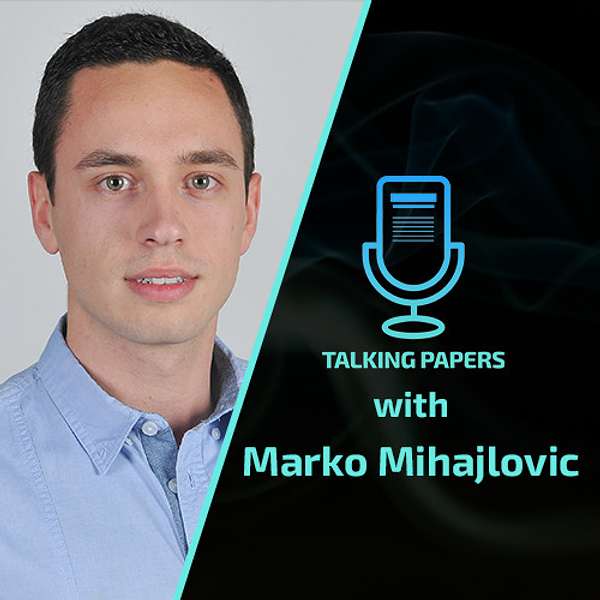
Talking Papers Podcast
🎙️ Welcome to the Talking Papers Podcast: Where Research Meets Conversation 🌟
Are you ready to explore the fascinating world of cutting-edge research in computer vision, machine learning, artificial intelligence, graphics, and beyond? Join us on this podcast by researchers, for researchers, as we venture into the heart of groundbreaking academic papers.
At Talking Papers, we've reimagined the way research is shared. In each episode, we engage in insightful discussions with the main authors of academic papers, offering you a unique opportunity to dive deep into the minds behind the innovation.
📚 Structure That Resembles a Paper 📝
Just like a well-structured research paper, each episode takes you on a journey through the academic landscape. We provide a concise TL;DR (abstract) to set the stage, followed by a thorough exploration of related work, approach, results, conclusions, and a peek into future work.
🔍 Peer Review Unveiled: "What Did Reviewer 2 Say?" 📢
But that's not all! We bring you an exclusive bonus section where authors candidly share their experiences in the peer review process. Discover the insights, challenges, and triumphs behind the scenes of academic publishing.
🚀 Join the Conversation 💬
Whether you're a seasoned researcher or an enthusiast eager to explore the frontiers of knowledge, Talking Papers Podcast is your gateway to in-depth, engaging discussions with the experts shaping the future of technology and science.
🎧 Tune In and Stay Informed 🌐
Don't miss out on the latest in research and innovation.
Subscribe and stay tuned for our enlightening episodes. Welcome to the future of research dissemination – welcome to Talking Papers Podcast!
Enjoy the journey! 🌠
#TalkingPapersPodcast #ResearchDissemination #AcademicInsights
Talking Papers Podcast
KeypointNeRF - Marko Mihajlovic
In this episode of the Talking Papers Podcast, I hosted Marko Mihajlovic . We had a great chat about his paper "KeypointNeRF: Generalizing Image-based Volumetric Avatars using Relative Spatial Encoding of Keypoints”, published in ECCV 2022.
In this paper, they create a generalizable NeRF for virtual avatars. To get a high-fidelity reconstruction of humans (from sparse observations), they leverage an off-the-shelf keypoint detector in order to condition the NeRF.
Marko is a 2nd year PhD student at ETH, supervised by Siyu Tang. His research focuses on photorealistic reconstruction of static and dynamic scenes and also modeling of parametric human bodies. This work was done mainly during his internship at Meta Reality Labs. Marko and I met at CVPR 2022.
AUTHORS
Marko Mihajlovic, Aayush Bansal, Michael Zollhoefer, Siyu Tang, Shunsuke Saito
ABSTRACT
Neural implicit fields have recently emerged as a useful representation for 3D shapes. These fields are Coordinate-based networks have emerged as a powerful tool for 3D representation and scene reconstruction. These networks are trained to map continuous input coordinates to the value of a signal at each point. Still, current architectures are black boxes: their spectral characteristics cannot be easily Image-based volumetric humans using pixel-aligned features promise generalization to unseen poses and identities. Prior work leverages global spatial encodings and multi-view geometric consistency to reduce spatial ambiguity. However, global encodings often suffer from overfitting to the distribution of the training data, and it is difficult to learn multi-view consistent reconstruction from sparse views. In this work, we investigate common issues with existing spatial encodings and propose a simple yet highly effective approach to modeling high-fidelity volumetric humans from sparse views. One of the key ideas is to encode relative spatial 3D information via sparse 3D keypoints. This approach is robust to the sparsity of viewpoints and cross-dataset domain gap. Our approach outperforms state-of-the-art methods for head reconstruction. On human body reconstruction for unseen subjects, we also achieve performance comparable to prior work that uses a parametric human body model and temporal feature aggregation. Our experiments show that a majority of errors in prior work stem from an inappropriate choice of spatial encoding and thus we suggest a new direction for high-fidelity image-based human modeling.
RELATED PAPERS
📚NeRF
📚IBRNet
📚PIFu
LINKS AND RESOURCES
💻Project website
📚 Paper
💻Code
🎥Video
To stay up to date with Marko's latest research, follow him on:
👨🏻🎓Personal Page
🐦Twitter
👨🏻🎓Google Scholar
CONTACT
If you would like to be a guest, sponsor or just share your thoughts, feel free to reach out via email: talking.papers.podcast@gmail
🎧Subscribe on your favourite podcast app: https://talking.papers.podcast.itzikbs.com
📧Subscribe to our mailing list: http://eepurl.com/hRznqb
🐦Follow us on Twitter: https://twitter.com/talking_papers
🎥YouTube Channel: https://bit.ly/3eQOgwP
